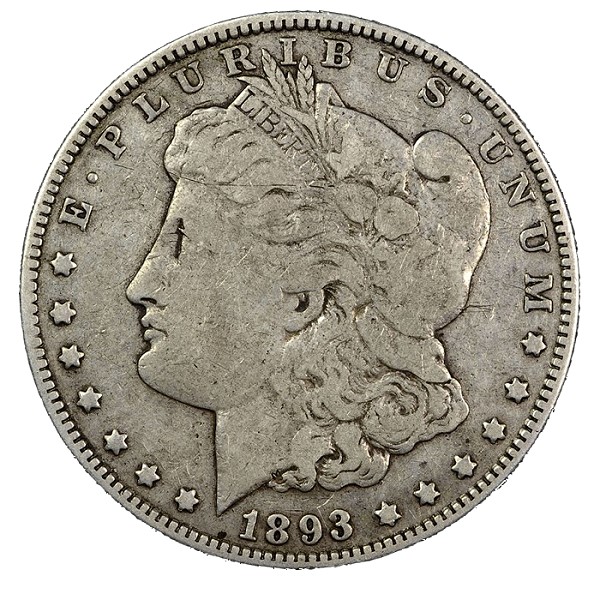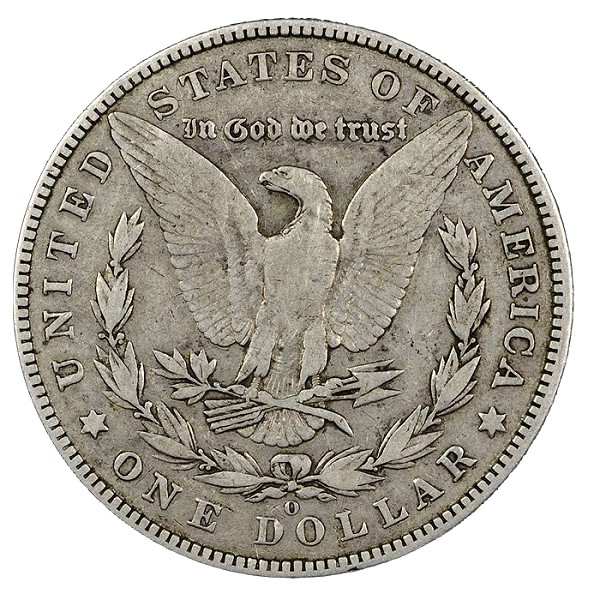
Counterfeit Coin Detection by Ben Wengel – Grader, NGC ……
A recent 1893-O Morgan Dollar submission was confirmed a counterfeit when NGC graders identified one telltale sign.
Recently, a well-made die struck counterfeit Morgan dollar dated 1893-O was found in a bulk deal while at NGC. While the piece was well made, it had one telltale diagnostic that made it much easier to identify as a counterfeit: the wrong reverse hub type.
From 1879-1899, all Morgan dollars were struck with the hub (the tool used to produce coining dies) identified by specialists as the “C3 Reverse Hub”, which is distinguished by the narrow gap between the eagle’s neck and the eagle’s right (facing) wing. This is referred to as the “C” hub by specialists because it is the third major reverse hub type for the Morgan Dollar series, the first being the “A” series for the eight tail feather pieces of 1878 and the second being the “B” series for the various 1878 seven tail feather pieces. The “C” series started with the 1878 Reverse of 1879 dollars and was last used for the 1904 dollars. The “D” series was used only in 1921. After 1899, Morgan dollars started to be minted with the C4 and C4/C3 (the C4/C3 hub is commonly known as the “two olive reverse”) hubs, identified by a much wider and more rounded gap between the eagle’s left (right, if you are the viewer) wing and neck.

Philadelphia and San Francisco began production of C4 and C4/C3 Morgan dollars in 1900 alongside the older C3 reverse pieces, before going exclusively to the new reverse hub type in 1901. New Orleans began production of these new reverse hubs in 1901 alongside the older C3 reverse pieces, before going exclusively to the new reverse hub type in 1902. All genuine Morgan dollars from 1902 to 1904 have this “wide gap” reverse.

The 1893-O submitted to NGC, however, had this wide gap C4 reverse—a reverse that was not used in New Orleans until 1901. As a result, this piece had to be a counterfeit.
Furthermore, the reverse die was able to be matched to a known counterfeit dollar. While the listing for the counterfeit reverse die isn’t found in the Comprehensive Catalog and Encyclopedia of Morgan and Peace Dollars by Leroy Van Allen and A. George Mallis, it is listed in New VAM Varieties of Morgan Dollars by Leroy Van Allen as a privately made piece, the 1896-O VAM-25 (VAM is an acronym of Van Allen-Mallis, the authors’ last names, and used to catalog Morgan dollar varieties). In addition to comparing the mintmark position, the die flaw evident as a raised lump in front of the D in UNITED served as additional confirmation that the 1893-O shares the same reverse die as 1896-O VAM-25.

While die struck fakes of New Orleans dollars dated 1896, 1900, 1901, and 1902 are known–for example, the Micro O counterfeits and similar pieces such as the 1896-O VAM-25 have been given listings as VAMs–this previously unknown 1893-O is currently unlisted in the VAM book. In fact, this “family” of counterfeits was thought to only span the years 1896-1902.
Outside of the wrong hub type, the 1893-O also has a slightly wavy and granular texture to it as well as a slight loss of sharpness in the devices, both of which are indicative of a counterfeit produced from the transfer die method. Several obverse die flaws are present on this counterfeit, including a raised lump between the second and third stars to the right of the date, and raised lumps above the letters B and U of the legend. The coin weighs 26.5 grams, well within mint tolerance for a Morgan dollar in Fine condition. When a metal test was conducted, the results read the coin was composed of 92.3% silver and 6.7% copper, which is actually above the 90% silver purity mandated by the Mint for minting dollars during this time, and is actually similar in purity to the Micro O and similar counterfeits, which are known to be made from slightly finer silver than 90%.

With an NGC US Coin Price Guide value of $230 for a genuine 1893-O dollar in Fine 12 condition, an unsuspecting or uneducated collector could easily lose hundreds of dollars by buying one of these pieces as genuine. Careful attention to details like hub types and die characteristics comes only from the serious study of a series over a number of years. Specialization in a series can significantly aid in counterfeit detection and, if there is any doubt, certification by NGC gives collectors the confidence to know that every nuance has been closely examined.
This newly discovered counterfeit die variety has been listed in the VAM reference as VAM-6.
Interested in reading more articles on Counterfeit Coin Detection? Click here.





Give been reporting counterfeit Morgans coming in from china for 5 years.I see them for sale in adds on Facebook.This is the first article I’ve seen.No one wants to do anything about it.Im out as a coin collector.
This is very discouraging for my interest in collecting Morgan dollars. The coins I buy are raw because they’re worn and lower circulated quality like this one. I actually like buying raw coins so I can put them in a nice coin album. I don’t care for the coin holders from grading services because I like to hold the coins.
My wife purchased separately a set of Morgan and a set of Trade Dollars from wish, one advertised as authentic and the other gave no reference to authenticity. She told me about the purchase when they were delivered at $100 each set, 28 coins in total. Immediately I began thinking counterfeit, then I opened the boxes. While they were well made, they were obvious fakes and non were labeled as such which is required by U.S. law. Adding to the problem, they decided to add as a thank you gift 4 well made counterfeit coins, 1-1921-D ($.10), 1-1914-S ($.25), 1-1938-D ($.50) and 1-1915-S ($.10). All 32 coins are non magnetic, close to the correct weight, diameter and edge and all in are in XF/AU condition and at first glance would appear authentic. If I were a newer collector and not armed with knowing the cost and origin of these sets, a loupe, books and 35 years of numismatic knowledge, it is possible that some would have found their way into my collection as important pieces. Instead I counterstamped them with a “C” and added them to my collection to pass on to other collectors.
The counterfeit coins are coming from China…be ware they’ll try anything…